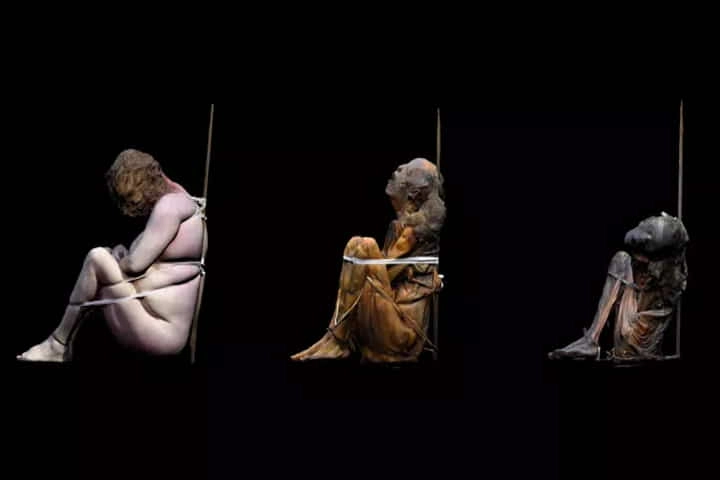

Illustration of guided natural mummification showing reduction of the soft tissue volume. (Pic. Courtesy Uppsala University and Linnaeus University in Sweden and University of Lisbon in Portugal)
<p>
With the discovery of remains of human beings in Portugal&rsquo;s Sado Valley, the distinction of having the oldest known mummies in the world could now rest with Europe. A report in news.artnet.com mentions that study conducted on these remains suggest that they are 8,000-year-old and thus by far the <a href="https://news.artnet.com/art-world/worlds-oldest-mummies-2081946" rel="nofollow">oldest known mummies</a>.</p>
<p>
With the help of the photographs clicked of the 13 bodies that had been unearthed in the 1960s, the scientists and archaeologists have been able to recreate the possible positions of the burial, besides bringing to spotlight the rituals connected with mortuary that were practised by the European Mesolithic people.</p>
<p>
The team of scientists and experts who conducted the study are from Sweden&rsquo;s Uppsala University and Linnaeus University and Portugal&rsquo;s University of Lisbon. The details of their work have been published in the European Journal of Archaeology and it puts forward the proposal that those living in the Sado Valley were involved in the removal of moisture through mummification.</p>
<p>
At present the absence of soft tissue on the bodies, makes it rather tough for the researchers to look for signs of such preservation. Using a technique that is called archaeothanatology experts documented and scrutinised the skeletons and studied the results of experiments done by the Forensic Anthropology Research Facility at Texas State University on decomposition.</p>
<p>
<strong>Also read: <a href="https://www.indianarrative.com/culture-news/formation-of-england-s-stonehenge-reveals-a-permanent-solar-calendar-154619.html">Formation of England&rsquo;s Stonehenge reveals a permanent Solar Calendar</a></strong></p>
<p>
Armed with information about decomposition of body and structural distribution of the bones, archaeologists deduced about the way Sado Valley people handled their dead. They used to bury them with knees bent and pressed against the chest.</p>
<p>
With the bodies drying up, those living would further secure the ropes that fastened the limbs in position, pressing them into a position that was desired. The burying of the dried bodies instead of the fresh corpse, indicates that some sort of mummification process and practices was adopted.</p>
<p>
Inspection of the bodies closely revealed that there is no break up in the joints as expected while the limbs exhibit hyperflexion. While the gathered sediments show articulation of the joints, it also proves that there was no decomposition of flesh following the burial.</p>
<p>
The purpose of mummification of the dead by Sado Valley people seems to be for carrying them easily to the place of burial and to ensure that the body retained its shape in life after burial. The ritual of mummification by the Europeans &ndash; dating back to thousands of years than what was thought of earlier &ndash; will help in better comprehension of Mesolithic beliefs, especially those connected with death and burial.</p>
<p>
Majority of the mummies found in the world are not more than 4,000 years old while the ancient Egyptians may have practised this method as early as 5,700 years ago. The bodies from coastal Chile &ndash; the Chinchorro mummies &ndash; have been considered as the world&rsquo;s oldest dating back to 7,000 years ago.</p>
India decisively asserted its military superiority over Pakistan during this month's brief but intense conflict,…
Trade associations and local business groups in Pakistan-occupied Gilgit-Baltistan (PoGB) launched an indefinite protest on…
A human chain and protest march was organized by various organizations in front of the…
The United States on Saturday announced the expansion of its security partnerships with India through…
Highlighting the use of indigenous platforms during Operation Sindoor, Chief of Defence Staff (CDS) General…
Congress MP Shashi Tharoor on Friday (local time) said that Colombia will issue a statement…